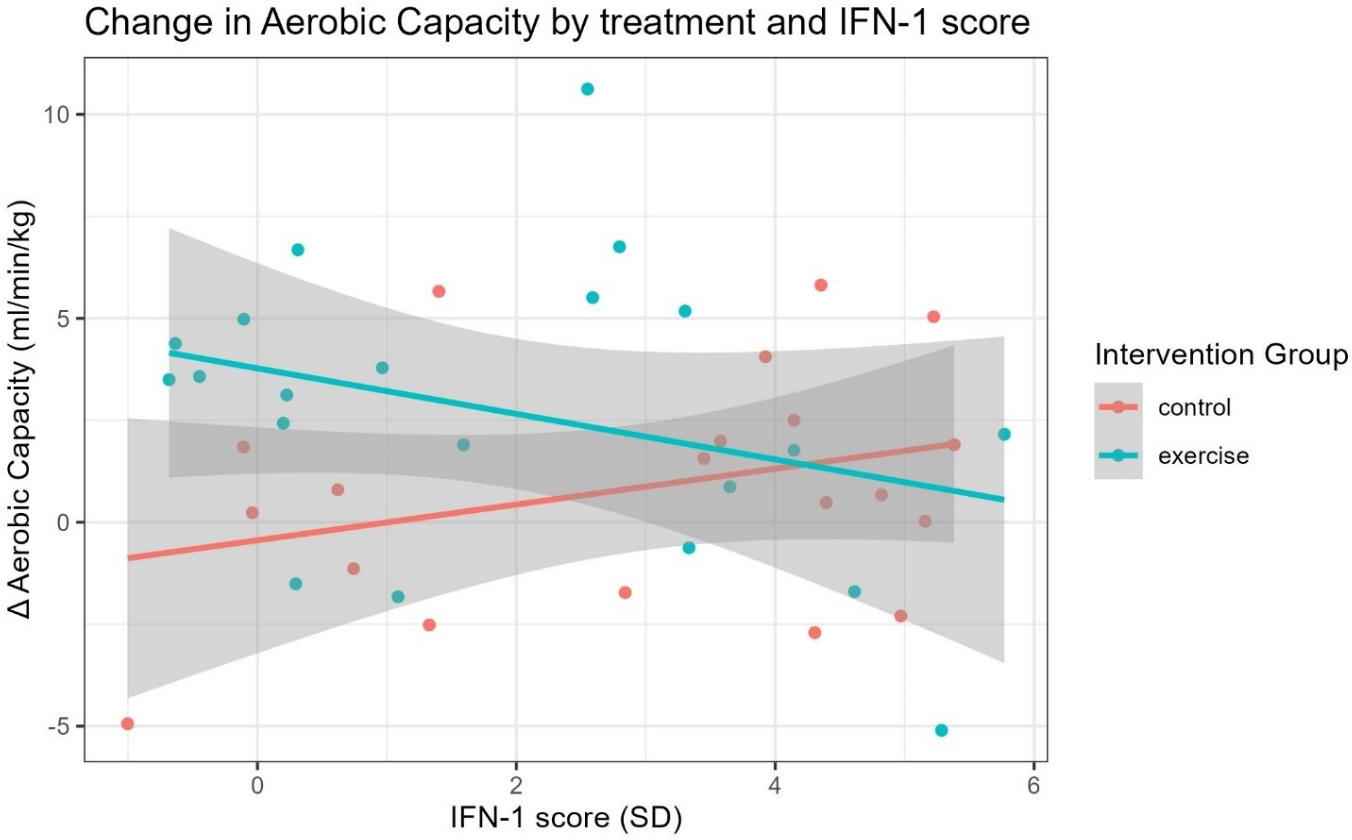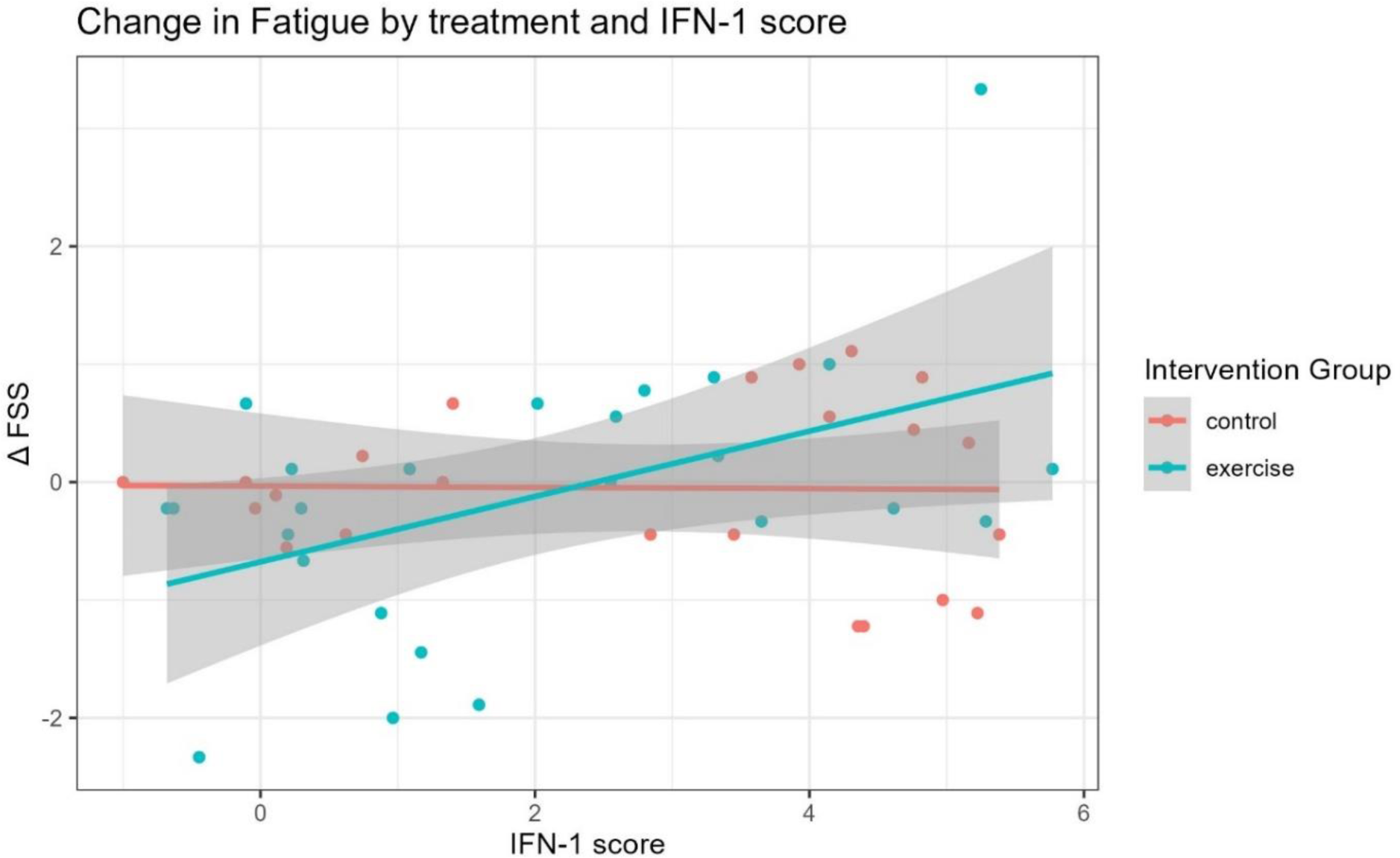

Background: Systemic lupus erythematosus (SLE) is an autoimmune disease, with a plethora of heterogenic symptoms, further characterized by immune dysfunctions including overactivity of type 1 interferon (IFN-1) [1, 2]. A majority of SLE patients experience ongoing fatigue and reduced aerobic capacity [3]. Current EULAR guidelines suggest exercise as an adjunctive therapy for fatigue in SLE patients [4]. Recent advances have implicated the immune system, especially IL-6 signaling, in adaptations to exercise [5]. Il-6 signaling can be altered in SLE patients, dependent on IFN-1 signaling [6].
Objectives: This study investigates effects of 12 weeks of thrice weekly high intensity training (HIIT) on fatigue and aerobic capacity in patients with SLE, and any effect modification by IFN-1.
Methods: Fifty-three patients with SLE were randomized 1:1 to thrice weekly HIIT (n=26) sessions or no intervention (n=27) for 12 weeks, with 49 completers. The co-primary outcomes were aerobic capacity and fatigue determined by the fatigue severity scale (FSS) [7]. IFN-1 was measured as a Z-score of genes in the manner of Chaussabel et al. The average treatment effect and its modification by IFN-1 were evaluated using a constrained linear mixed model adjusted for sex.
Results: Following exercise, aerobic capacity was on average 2.31 ml/kg/min higher (CI 0.55 to 4.1, adj-p=0.006) compared to control. Moreover, the estimated treatment effect decreased by 0.56 ml/kg/min per SD of IFN-score (CI -0.38 to 1.49, adj-p=0.35) see Figure 1A for a graphical depiction of the effect of IFN-1 score on aerobic capacity following intervention. Similarly, fatigue was on average 0.66 points lower (CI -0.26 to 1.58, adj-p=0.203) following exercise compared to control and increased by 0.29 points per SD of IFN-score (CI -0.03 to 0.61, adj-p= 0.268), see Figure 1B for a graphical depiction of the effect of IFN-1 score on FSS following intervention.
Conclusion: HIIT increased aerobic capacity of SLE patients but did not alleviate fatigue. Due to the tendency towards significance, observations of the interactions should be interpreted cautiously. A trend towards increased IFN-1 signaling diminishing the beneficial effects of exercise on fatigue and aerobic capacity, was observed, but would require further studies with slightly larger sample size, or a different hierarchy of hypotheses to confirm. Previous studies that have not taken IFN-scores into account might have accidentally recruited too many participants with lower IFN-1 scores and seen an inflated effect, or have included a participant group with a similar spread as this one, and seen almost no effects on fatigue severity.
A – Change in aerobic capacity between baseline and follow-up.
Ifn-1 SCORE = INTERFERON Type 1 ACTIVITY AS MEASURED BY THE IFN-1 Score COMPROMISING THE MEAN ACTIVITY OF 41 GENES NORMALIZED TO 9 Healthy individuals. Bonferroni Corrected difference of slopes: p=0.1162

B – Change in FSS = Fatigue Severity Scale between baseline and follow-up.
Ifn-1 SCORE = INTERFERON Type 1 ACTIVITY AS MEASURED BY THE IFN-1 Score COMPROMISING THE MEAN ACTIVITY OF 41 GENES NORMALIZED TO 9 Healthy individuals. Bonferroni Corrected difference of slopes: p=0.0686

REFERENCES: [1] Baechler EC, Batliwalla FM, Karypis G, et al. Interferon-inducible gene expression signature in peripheral blood cells of patients with severe lupus. Proc Natl Acad Sci U S A. 2003;100(5):2610-2615. doi:10.1073/PNAS.0337679100/
[2] Chiche L, Jourde-Chiche N, Whalen E, et al. Modular transcriptional repertoire analyses of adults with systemic lupus erythematosus reveal distinct type I and type II interferon signatures. Arthritis Rheumatol (Hoboken, NJ). 2014;66(6):1583-1595. doi:10.1002/ART.38628.
[3] Kaul A, Gordon C, Crow MK, et al. Systemic lupus erythematosus. Nat Rev Dis Prim. 2016;2. doi:10.1038/NRDP.2016.39.
[4] Dures E, Farisoğullari B, Santos EJF, et al. 2023 EULAR recommendations for the management of fatigue in people with inflammatory rheumatic and musculoskeletal diseases. Ann Rheum Dis. 2023;0(11):34. doi:10.1136/ARD-2023-224514.
[5] Wedell-Neergaard AS, Lang Lehrskov L, Christensen RH, et al. Exercise-Induced Changes in Visceral Adipose Tissue Mass Are Regulated by IL-6 Signaling: A Randomized Controlled Trial. Cell Metab. 2019;29(4):844-855.e3. doi:10.1016/j.cmet.2018.12.007.
[6] Enocsson H, Gullstrand B, Eloranta ML, et al. C-Reactive Protein Levels in Systemic Lupus Erythematosus Are Modulated by the Interferon Gene Signature and CRP Gene Polymorphism rs1205. Front Immunol. 2021;11(January):1-6. doi:10.3389/fimmu.2020.622326.
[7] Schwartz JE, Jandorf L, Krupp LB. THE MEASUREMENT OF FATIGUE: A NEW INSTRUMENT. J Psyrhmwmaric Res. 1993;37(7):753-762.
Acknowledgements: We would like to acknowledge the participant panel who helped guide the conduct, analysis and discussion of this study.
Disclosure of Interests: Malte Lund Adamsen In 2022 I received 5000DKK as a speaking fee from a Novartis Conference on physical activity in rheumatic diseases, This research is funded by the Novo Nordisk Foundation, Trygfonden, The Danish Rheumatism Association and University Hospital of Sjælland, Holbæk Hospital, Iben Rasmussen: None declared, Mark Lyngbæk: None declared, Pil Hoejgaard: None declared, Søren Jacobsen: None declared.
© The Authors 2025. This abstract is an open access article published in Annals of Rheumatic Diseases under the CC BY-NC-ND license (